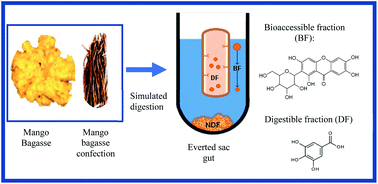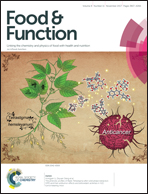Mango-bagasse functional-confectionery: vehicle for enhancing bioaccessibility and permeability of phenolic compounds
Abstract
Functional confectionery can be exploited as a vehicle for the protection of phenolic compounds (PCs) and for enhancing absorption during the gastrointestinal (GI) process. In this study, a confection containing 20% of mango bagasse (MB), gelatin and pectin was formulated. The PC profile, antioxidant capacity, in vitro bioaccessibility and apparent permeability (Papp) during mouth–stomach–intestine digestion (15, 30, 60, 120 min) and in vitro colonic fermentation (6, 12, 24 h) were evaluated for MB and the mango bagasse confection (MBC). HPLC-DAD analysis showed that mangiferin (830.69 μg g−1) was the most abundant compound in MBC. Total PCs (4.14 mg g−1), quercetin (244.83 μg g−1), and gallic acid (GA) (285.43 μg g−1) were highly bioaccessible mainly at the intestine at 60–120 min of digestion. GA was the most bioaccessible compound. Total flavonoids (TFs) and condensed tannins (CTs) had the maximum bioaccessibility in the mouth and stomach, respectively. For the permeability studies, PCs showed efflux rather than uptake in the intestine. Those compounds that exhibited intestinal absorption were mangiferin > GA > total PCs > TFs, whereas quercetin and CT absorption was negligible. The antioxidant capacity remained unchanged along the GI, mangiferin and quercetin being the most likely compounds to exert this activity. Overall results indicate that MBC has higher bioaccessibility, absorption and antioxidant capacity than MB, suggesting an effective protective role of gelatin and pectin, giving insight into the potential of MBC as a functional food.



 Please wait while we load your content...
Please wait while we load your content...